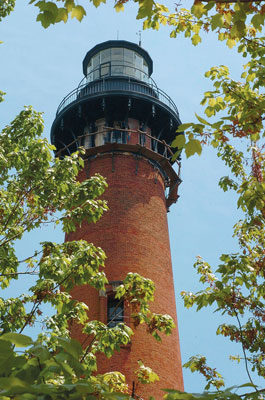Officials hoping funds will shore up sources for sand
Wilmington Star by Gareth McGrath (1/10/06)
When Hurricane Isabel slammed into the Outer Banks in September 2003, the Category 2 storm blasted a new inlet just north of Hatteras Village. It took crews nearly two months and 400,000 cubic yards of sand to fill the 2,000-foot-wide hole in the barrier island. But officials said they were fortunate to have a high-quality sand source nearby to mine: the Hatteras Island-Ocracoke ferry channel. "We realize we were lucky in that regard," said the N.C. Department of Transportation's Roy Shelton, who is chairman of the Outer Banks Task Force, a multi-agency group that looks at transportation challenges on the chain of barrier islands. To make sure it has options if another inlet needs plugging, the state Board of Transportation this week is expected to approve spending $125,000 to find sources of sand offshore near four "hot spots" along the Outer Banks. The work, to be performed by the N.C. Geological Survey over the next two years, will analyze data that's already been collected by the U.S. Geological Survey as part of a detailed five-year look at the Outer Banks. "This study takes that data from the broader study and focuses on four locations that are most prone to open up new inlets, either because they are historical trouble spots or the study showed them to be potential problems areas," said Tyler Clark, chief geologist with the NCGS. The hot spots - basically skinny portions of the Outer Banks where there's little sand - are areas where the DOT struggles to keep N.C. 12 open. They are near the northern end of Ocracoke Island, at the old Isabel Inlet and by Buxton and Rodanthe. But state officials insist the new proposal doesn't mean they wouldn't consider alternatives to filling a new inlet. "That's not to say it's a foregone conclusions that they would be filled," Shelton said. "But if that's one of the alternatives, then having this information beforehand would allow us to make a better decision." Environmentalists and some researchers have said pumping sand back into a breach is a shortsighted fix based on economics and politics rather than sound scientific principles or the best use of taxpayer money. Other options include bridging inlets, establishing new ferry services and retreating from areas that are severely eroded or isolated. Stanley Riggs, a geologist with East Carolina University, notes that historically the Outer Banks has experienced the regular opening and closing of inlets. As many as a dozen openings were around when the first colonists landed more than 400 years ago. Today there are three inlets - Oregon, Hatteras and Ocracoke. "From a natural point of view, they are wanted and needed by the coastal system," Riggs said. Stan White, who represents the Outer Banks on the state Board of Transportation, said the DOT isn't predetermining a course of action if a new inlet is created. "We would be remiss if we weren't prepared," he said. "We need to have our options available to us." Riggs agrees that knowing the best sources of sand is simply smart planning. But he added that actually pumping it into a breach might not be the best decision. "Our management approach right now is to try and stabilize a nonstable barrier island," Riggs said, "and in the long run that's probably not good for the barrier island or the development that's on it."
Wrightsville won't get billed for dredging
Wilmington Star by John Desantis (1/10/06)
Wrightsville Beach was let off the hook Monday night in a dispute with neighboring Figure Eight Island over dredging of Mason Inlet. New Hanover County Commissioners ditched a proposal that would have forced a sharing of costs in a tight timeline. The issue was shoaling of Mason Inlet, which separates the two island communities, and the limited time in which it can be dredged while equipment remains in the waterway. Under the proposal considered by commissioners, Figure Eight would have paid for the sand once it was delivered to shore up their storm-damaged beaches, while Wrightsville - benefiting from the clearing of the waterway - would be indebted to the tune of about $60,000. "It has been made very, very clear there is no requirement to do dredging in Mason Inlet at this time," Frank Pinkston, chairman of the Mason Inlet Preservation Group told commissioners, representing only one side of the inlet - that bordering Wrightsville. Bill Raney, an attorney representing the Figure Eight Homeowners Association, said it was in the best interests of the county and the inlet for the proposed agreement to be approved. "The real important issue here is what is the right thing to do to make this project work the best," Raney said. Chris Gibson, a consulting engineer for the county, said the damage done by Ophelia created a new urgency for the dredging, and suggested that getting the work done now, which would require the Wrightsville involvement, was the best course. But commissioners, for the most part, indicated they were not willing to commit Wrightsville Beach to paying for something it did not see as essential. The result, after more than an hour of spirited discussion, was a resolution that the current sand-removal program - financed by Figure Eight Island only - continue, which could result in delays to some dredging. Commissioners noted that there was no proof of any requirement by the Army Corps of Engineers that the dredging be done immediately. Commissioner Ted Davis was the lone vote opposing the measure his colleagues proposed, expressing concerns that an opportunity to do needed work on the inlet could be passed up. In other business, the commissioners approved a $1 million telephone system that will replace all telephones used by their agencies. IT Director Leslie Stanfield assured them that the new system would pay for itself in five years, and turned down a special use permit that would have allowed Cingular Wireless to erect a cell phone tower on Murray Farms Road.
"Beach News" is a courtesy service provided by the Carteret County Shore Protection Office that furnishes on-line news relevant to the beaches of North Carolina with special emphasis to Carteret County. Please e-mail rudi@carteretcountygov.org <mailto:rudi@co.carteretcountygov.org> if you wish to be removed from or added to "Beach News". Archived "Beach News" is available at www.protectthebeach.com/beachnews 2006.htm <http://www.protectthebeach.com/beachnews 2006.htm> .
www.protectthebeach.com <http://www.protectthebeach.com>



 "Messy Job"
"Messy Job" Snow on the picnic table.
Snow on the picnic table. Snow on the steps
Snow on the steps







